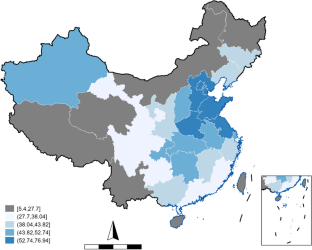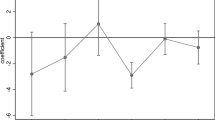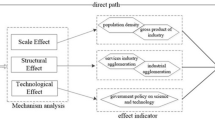Abstract
Using panel data for 277 Chinese cities, this paper applies a time-varying difference-in-differences (DID) model to empirically test the impact of China’s carbon emissions trading scheme (ETS) on urban air quality, and further explores its heterogeneity and the mechanisms involved. The results show that ETS can improve urban air quality. This conclusion remains robust through a series of robustness tests, including PSM-DID estimation, varying window periods, exclusion of significant events, lag phase, and placebo tests. The dynamic effect test indicates that ETS has a continuous and effective effect on improving urban air quality. Mechanism analysis reveals that the degree of marketization can enhance the improvement effect that ETS has on urban air quality. Meanwhile, industrial structure upgrading and green technology innovation are important mechanisms by which pilot ETS policy improves urban air quality. Regional heterogeneity analysis finds that ETS only improves urban air quality in eastern and central regions.






Similar content being viewed by others
Data availability
The datasets used, generated, and analyzed during the current study are available in the China City Statistical Yearbook, Statistical Yearbook of each province in China, China National Intellectual Property Database, and EPS China Data.
References
An J, Lee J (2018) A newsvendor non-cooperative game for efficient allocation of carbon emissions. Sustainability 10:154. https://doi.org/10.3390/su10010154
Ankit V, Bagepally BS, Balachandar R, Mansuri M (2022) Pulmonary function changes on exposure to air pollutants: inferences from systematic review and meta-analysis of observational studies involving traffic regulators. J Transp Health 25:101363. https://doi.org/10.1016/j.jth.2022.101363
Bai J, Zhang Y, Bian Y (2022) Does innovation-driven policy increase entrepreneurial activity in cities—evidence from the national innovative city pilot policy. China Ind Econ 61–78. https://doi.org/10.19581/j.cnki.ciejournal.2022.06.016
Bao R, Liu T (2022) How does government attention matter in air pollution control? Evidence from government annual reports. Resour Conserv Recycl 185:106435. https://doi.org/10.1016/j.resconrec.2022.106435
Beck T, Levine R, Levkov A (2010) Big bad banks? The winners and losers from bank deregulation in the United States. J Finance 65:1637–1667. https://doi.org/10.1111/j.1540-6261.2010.01589.x
Calel R, Dechezlepretre A (2016) Environmental policy and directed technological change: evidence from the European carbon market. Rev Econ Stat 98:173–191. https://doi.org/10.1162/REST_a_00470
Castells-Quintana D, Dienesch E, Krause M (2021) Air pollution in an urban world: a global view on density, cities and emissions. Ecol Econ 189:107153. https://doi.org/10.1016/j.ecolecon.2021.107153
Chen S, Chen D (2018) Air pollution, government regulations and high-quality economic development. Econ Res J 53:20–34
Chloe D, Paul D, Genia H (2022) Assessing how big insurance firms report and manage carbon emissions: a case study of Allianz. Sustainability 14:2476. https://doi.org/10.3390/su14042476
Deng H, Yang L (2019) Haze governance, local competition and industrial green transformation. China Ind Econ 10:118–136
Deng H, Yang L, Pan X (2020) High-speed rail and industrial upgrading in China: facts and mechanisms. J Finance Econ 46:34–48
Dong Z, Xia C, Fang K, Zhang W (2022) Effect of the carbon emissions trading policy on the co-benefits of carbon emissions reduction and air pollution control. Energy Policy 165:112998. https://doi.org/10.1016/j.enpol.2022.112998
Du L, Ding Z, Li B (2012) Industrial structure adjustment is upgrading: boost from the mechanism of carbon finance — empirical research based on European data-base. J Tsinghua Univ (Philosophy and Social Sciences) 27:143–150+161. https://doi.org/10.13613/j.cnki.qhdz.002121
Fan G, Wang X, Zhu H (2007) China marketization index: Report on relative progress of marketization by region 2006. Economic Science Press, Beijing
Fan G, Wang X, Zhu H (2010) China marketization index: report on relative progress of marketization by region 2009. Economic Science Press, Beijing
Feng Y, Zhang Y, Liu Z (2020) Energy prices, technological progress and energy intensity—dynamic spatiotemporal evolution based on Chinese urban data. Urban Environ Stud 3:69–92
Guo J, Guo Y, Wu X (2020) Analysis of the impact of major events on urban air quality based on PSM-DID. J Appl Stat Manag 40:787–798. https://doi.org/10.13860/j.cnki.sltj.20201219-011
Hammer MS, van Donkelaar A, Li C et al (2020) Global estimates and long-term trends of fine particulate matter concentrations (1998–2018). Environ Sci Technol 54:7879–7890. https://doi.org/10.1021/acs.est.0c01764
Hu M, Li Z, Song W (2021a) Analysis of the impact of environmental regulation on PM2.5 pollution in Chinese prefecture-level cities. Resour Environ Yangtze Basin 30:2166–2177
Hu W, Tian J, Chen L (2021b) An industrial structure adjustment model to facilitate high-quality development of an eco-industrial park. Sci Total Environ 766:142502. https://doi.org/10.1016/j.scitotenv.2020.142502
Jiao L, Luo F, Wu F et al (2022) Can the opening of urban rail transit improve urban air quality? Evidence from 94 lines in China. Environ Impact Assess Rev 97:106857. https://doi.org/10.1016/j.eiar.2022.106857
Jing G (2022) Pilot policies for carbon emission trading and high-quality development of regional economy. Contemp Econ Manag 44:50–59
Kim K-N, Ha B, Seog W, Hwang I-U (2022) Long-term exposure to air pollution and the blood lipid levels of healthy young men. Environ Int 161:107119. https://doi.org/10.1016/j.envint.2022.107119
Koengkan M, Fuinhas JA, Kazemzadeh E et al (2022) The impact of renewable energy policies on deaths from outdoor and indoor air pollution: empirical evidence from Latin American and Caribbean countries. Energy 245:123209. https://doi.org/10.1016/j.energy.2022.123209
Kong H, Jin ST, Sui DZ (2023) Can transportation network companies improve urban air quality? Transp Res Part D: Transp Environ 119:103767. https://doi.org/10.1016/j.trd.2023.103767
Li C, Li X, Song D, Tian M (2022) Does a carbon emissions trading scheme spur urban green innovation? Evidence from a quasi-natural experiment in China. Energy Environ 33:640–662. https://doi.org/10.1177/0958305X211015327
Li G, Zhang W (2017) Research on industrial carbon emissions and emissions reduction mechanism in China’s ETS. China Popul Resour Environ 27:141–148
Li Z, Wang J (2022) Spatial spillover effect of carbon emission trading on carbon emission reduction: empirical data from pilot regions in China. Energy 251:123906. https://doi.org/10.1016/j.energy.2022.123906
Liu B, Wang Y, He M et al (2022) Dramatic changes in atmospheric pollution source contributions for a coastal megacity in northern China from 2011 to 2020. Atmos Chem Phys 22:8597–8615. https://doi.org/10.5194/acp-22-8597-2022
Liu J-Y, Woodward RT, Zhang Y-J (2021) Has carbon emissions trading reduced PM 2.5 in China? Environ Sci Technol 55:6631–6643. https://doi.org/10.1021/acs.est.1c00248
Liu Y (2022) Effect of carbon emission restriction policies on air quality in China’s key cities. J Hunan Univ Soc Sci 36:73–81
Liu M, Cheng S (2022) Does the carbon emission trading scheme promote the optimization and upgrading of regional industrial structure? Manage Rev 34:33–46. https://doi.org/10.14120/j.cnki.cn11-5057/f.2022.07.015
Liu M, Li Y (2022) Environmental regulation and green innovation: evidence from China’s carbon emissions trading policy. Finance Res Lett 48:103051. https://doi.org/10.1016/j.frl.2022.103051
Liu Z, Sun H (2021) Assessing the impact of emissions trading scheme on low-carbon technological innovation: evidence from China. Environ Impact Assess Rev 89:106589. https://doi.org/10.1016/j.eiar.2021.106589
López R, Galinato GI, Islam A (2011) Fiscal spending and the environment: theory and empirics. J Environ Econ Manag 62:180–198. https://doi.org/10.1016/j.jeem.2011.03.001
Marion L, Philippe Q (2022) Air pollution and CO2 from daily mobility: who emits and why? Evidence from Paris. Energy Econ 109:105941. https://doi.org/10.1016/j.eneco.2022.105941
Mujtaba A, Jena PK, Mishra BR et al (2022) Do economic growth, energy consumption and population damage the environmental quality? Evidence from five regions using the nonlinear ARDL approach. Environ Chall 8:100554. https://doi.org/10.1016/j.envc.2022.100554
Pan X, Fu W (2022) Environmental information disclosure and regional air quality: a quasi-natural experiment based on the PM2.5 monitoring. J Finance Econ 48:110–124. https://doi.org/10.16538/j.cnki.jfe.20220113.402
Peyman H, Carrie ML (2022) Ecologically unequal exchange and disparate death rates attributable to air pollution: a comparative study of 169 countries from 1991 to 2017. Environ Res 212:113161. https://doi.org/10.1016/j.envres.2022.113161
Qi S, Zhang Z (2019) EU ETS, EUA allocation and renewable energy technological innovation. World Econ Stud 119–133+136. https://doi.org/10.13516/j.cnki.wes.2019.09.009
Qi Y, Zhang Y (2016) Research on the influence mechanism of regional industrial structure evolution to PM2.5 emissions. Soft Sci 30:54–60. https://doi.org/10.13956/j.ss.1001-8409.2016.11.12
Qiang WW, Luo H, Xiao Y et al (2023) Can urban polycentricity improve air quality? Evidence from Chinese cities. J Clean Prod 406:137080. https://doi.org/10.1016/j.jclepro.2023.137080
Ren Y, Fu J (2019) Research on the effect of carbon emissions trading on emission reduction and green development. China Popul Resour Environ 29:11–20
Shi D, Li S (2020) Emissions trading system and energy use efficiency—measurements and empirical evidence for cities at and above the prefecture level. China Ind Econ 5–23. https://doi.org/10.19581/j.cnki.ciejournal.2020.09.001
Shi B, Li N, Gao Q, Li G (2022) Market incentives, carbon quota allocation and carbon emission reduction: evidence from China’s carbon trading pilot policy. J Environ Manage 319:115650. https://doi.org/10.1016/j.jenvman.2022.115650
Song D, Zhu W, Wang B (2021) Micro-empirical evidence based on China’s carbon trading companies: carbon emissions trading, quota allocation methods and corporate green innovation. China Popul Resour Environ 31:37–47
Sun C, Xu S, Yang M, Gong X (2022) Urban traffic regulation and air pollution: a case study of urban motor vehicle restriction policy. Energy Policy 163:112819. https://doi.org/10.1016/j.enpol.2022.112819
Szyszkowicz M (2022) Urban air pollution and mental, eye, digestive, and musculoskeletal health problems in Toronto, Canada. Hyg Environ Health Adv 3:100008. https://doi.org/10.1016/j.heha.2022.100008
Teixidó J, Verde SF, Nicolli F (2019) The impact of the EU Emissions Trading System on low-carbon technological change: the empirical evidence. Ecol Econ 164:106347. https://doi.org/10.1016/j.ecolecon.2019.06.002
Tesfaldet YT, Chanpiwat P (2023) The effects of meteorology and biomass burning on urban air quality: the case of Bangkok. Urban Climate 49:101441. https://doi.org/10.1016/j.uclim.2023.101441
Tian H, Lin J, Jiang C (2022) The impact of carbon emission trading policies on enterprises’ green technology innovation—evidence from listed companies in China. Sustainability 14:7207. https://doi.org/10.3390/su14127207
Wang Q, Lu F (2021) Economic effects of high-speed rail: emission reduction and efficiency enhancement. Stat Res 38:29–44. https://doi.org/10.19343/j.cnki.11-1302/c.2021.02.003
Wang Y, Zhao H (2019) The impact of China’s carbon trading market on regional carbon emission efficiency. China Popul Resour Environ 29:50–58
Wang X, Fan G, Yu J (2017) Marketization Index Report of China by Province (2016). Social Sciences Academic Press, Beijing
Wang X, Zhu L, Fan Y (2018) Transaction costs, market structure and efficient coverage of emissions trading scheme: a microlevel study from the pilots in China. Appl Energy 220:657–671. https://doi.org/10.1016/j.apenergy.2018.03.080
Wang X, Zhu L, Liu P (2021a) Manipulation via endowments: quantifying the influence of market power on the emission trading scheme. Energy Econ 103:105533. https://doi.org/10.1016/j.eneco.2021.105533
Wang B, Zhen F, Zhang S et al (2021b) The impact of air pollution on urban vibrancy and its built environment heterogeneity: an empirical analysis based on big data. Geogr Res 40:1935–1948
Wang J, Kim J, Shao W (2020) Investigation of the implications of “Haze Special Law” on air quality in South Korea. Complexity 2020:1–18. https://doi.org/10.1155/2020/6193016
Wang Z, Liang L, Cheng D et al (2022a) Emission reduction benefits and economic benefits of China’s pilot policy on carbon emission trading system. Comput Intell Neurosci 2022:1–13. https://doi.org/10.1155/2022/5280900
Wang X, Liu C, Wen Z et al (2022b) Identifying and analyzing the regional heterogeneity in green innovation effect from China’s pilot carbon emissions trading scheme through a quasi-natural experiment. Comput Ind Eng 174:108757. https://doi.org/10.1016/j.cie.2022.108757
Wang X, Fan G, Hu L (2019a) Marketization Index Report of China by Province (2018). Social Sciences Academic Press, Beijing
Wang X, Zhang X-B, Zhu L (2019b) Imperfect market, emissions trading scheme, and technology adoption: a case study of an energy-intensive sector. Energy Econ 81:142–158. https://doi.org/10.1016/j.eneco.2019.03.014
Weng Z, Liu T, Wu Y, Cheng C (2022) Air quality improvement effect and future contributions of carbon trading pilot programs in China. Energy Policy 170:113264. https://doi.org/10.1016/j.enpol.2022.113264
Wu Y, Qi J, Xian Q, Chen J (2021) The carbon emission reduction effect of China’s carbon market: from the perspective of the coordination between market mechanism and administrative intervention. China Ind Econ 114–132. https://doi.org/10.19581/j.cnki.ciejournal.2021.08.007
Xu J, Cui J (2020) Low-carbon cities and firms’ green technological innovation. China Ind Econ 178–196. https://doi.org/10.19581/j.cnki.ciejournal.2020.12.008
Yang H, Ma J (2021) Correlation analysis between regional economic differences and environmental pollution based on Kuznets curve model. Environ Technol Innov 22:101444. https://doi.org/10.1016/j.eti.2021.101444
Yang T, Zhu Y, Liu M, Zhou B (2020) Industrial co-agglomeration, marketization and environmental pollution in resource-based cities. Ind Econ Res 15–27. https://doi.org/10.13269/j.cnki.ier.2020.06.002
Yang Z, Yuan Y, Zhang Q (2022) Carbon emission trading scheme, carbon emissions reduction and spatial spillover effects: quasi-experimental evidence from China. Front Environ Sci 9:824298. https://doi.org/10.3389/fenvs.2021.824298
Yu H, Jiang Y, Zhang Z et al (2022) The impact of carbon emission trading policy on firms’ green innovation in China. Financ Innov 8:1–24. https://doi.org/10.1186/s40854-022-00359-0
Zhang C, Guo S (2017) The influence of industrial emission on the haze in Huai’an. Ind Sci Trib 16:72–73
Zhang G, Zhang N (2022) Mental health effects of air pollution in the context of Healthy China Initiative. China Popul Resour Environ 32:15–25
Zhao A, Xiang K, Liu X, Zhang X (2022b) Spatio-temporal evolution patterns of PM2.5 and relationship with urban expansion in Beijing-Tianjin-Hebei urban agglomeration from 2000 to 2018. Environ Sci 43:2274–2283. https://doi.org/10.13227/j.hjkx.202109226
Zhao H, Li S, Wu Z (2022a) The influence of central environmental inspection on the transformation and upgrading of manufacturing enterprises—based on the test of mediator effect of marketization process. Manage Rev 34:3–14. https://doi.org/10.14120/j.cnki.cn11-5057/f.20210623.002
Zhao S, Lu L (2022) Does air pollution affect people’s reproductive behavior: evidence from China. China Econ Stud 61–75. https://doi.org/10.19365/j.issn1000-4181.2022.01.05
Zhou F, Wang X (2022) The carbon emissions trading scheme and green technology innovation in China: a new structural economics perspective. Econ Anal Policy 74:365–381. https://doi.org/10.1016/j.eap.2022.03.007
Zhu J, Ge Z, Wang J et al (2022) Evaluating regional carbon emissions trading in China: effects, pathways, co-benefits, spillovers, and prospects. Clim Policy 22:918–934. https://doi.org/10.1080/14693062.2022.2054765
Zhu L, Wang X, Zhang D (2020) Identifying strategic traders in China’s pilot carbon emissions trading scheme. EJ 41: 123–142. https://doi.org/10.5547/01956574.41.2.lzhu
Funding
This research is supported by National Natural Science Foundation of China (Grant No. 71903114; Grant No. 72004122) and Youth Innovation Team Program of Shandong Higher Education Institution (Grant No. 2022RW049).
Author information
Authors and Affiliations
Contributions
All authors contributed to the study conception and design. Material preparation, data collection, and analysis were performed by Di Cao. The first draft of the manuscript was written by Haibo Sun and Di Cao.
Corresponding author
Ethics declarations
Conflict of interest
The authors declare no competing interests.
Additional information
Responsible Editor: V.V.S.S. Sarma
Publisher's Note
Springer Nature remains neutral with regard to jurisdictional claims in published maps and institutional affiliations.
Rights and permissions
Springer Nature or its licensor (e.g. a society or other partner) holds exclusive rights to this article under a publishing agreement with the author(s) or other rightsholder(s); author self-archiving of the accepted manuscript version of this article is solely governed by the terms of such publishing agreement and applicable law.
About this article
Cite this article
Sun, H., Cao, D. Impact of China’s carbon emissions trading scheme on urban air quality: a time-varying DID model. Environ Sci Pollut Res 30, 103862–103876 (2023). https://doi.org/10.1007/s11356-023-29465-x
Received:
Accepted:
Published:
Issue Date:
DOI: https://doi.org/10.1007/s11356-023-29465-x




